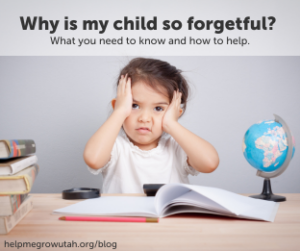 It may surprise you to learn that forgetfulness is an important part of memory (imagine the burden of remembering every single thing we ever experienced!). But for most intents and purposes, remembering things is, of course, very helpful. The question of why your child is so forgetful depends on many factors; first of all: developmental level! Even unborn babies in the last few months of prenatal development can remember things! Newborn babies recognize songs that were sung to them repeatedly or stories that were told to them, while they were still in the womb. They recognize voices and voice patterns and will turn toward familiar sounds more often than to an unfamiliar sound. In the early stages of development, babies learn to remember routine events that they experience over and over again (such as the voices of their parents, feeling fulfilled after eating, being put to bed after taking a bath, or the sight and sounds of the family dog). These early memories depend on the context that the events were happening in, and the younger babies are, the more exact reminders they need in order to remember. Babies also do not yet have language to help them remember things. They develop so-called implicit memory (how things are done in specific situations) but not yet explicit memories that they can remember and express in language.
It may surprise you to learn that forgetfulness is an important part of memory (imagine the burden of remembering every single thing we ever experienced!). But for most intents and purposes, remembering things is, of course, very helpful. The question of why your child is so forgetful depends on many factors; first of all: developmental level! Even unborn babies in the last few months of prenatal development can remember things! Newborn babies recognize songs that were sung to them repeatedly or stories that were told to them, while they were still in the womb. They recognize voices and voice patterns and will turn toward familiar sounds more often than to an unfamiliar sound. In the early stages of development, babies learn to remember routine events that they experience over and over again (such as the voices of their parents, feeling fulfilled after eating, being put to bed after taking a bath, or the sight and sounds of the family dog). These early memories depend on the context that the events were happening in, and the younger babies are, the more exact reminders they need in order to remember. Babies also do not yet have language to help them remember things. They develop so-called implicit memory (how things are done in specific situations) but not yet explicit memories that they can remember and express in language.
Around two years of age, the hippocampus (the main area of the brain that is responsible for memory) makes a developmental leap. Suddenly, toddlers remember that there was a shadow in their room last night that they are still scared of today. The hippocampus registers memories, especially the ones that are accompanied by strong emotion, such as fear or joy (which are registered in the amygdala, an almond-shaped brain structure that is right next to the hippocampus). Processing speed is another aspect of laying down memories. For example, toddlers who have faster processing speed can learn language sounds faster, which enables them to also learn and remember new words more quickly (see this interesting TED talk by Professor Anne Fernald).
Even when children can speak in multiple sentences, and they can repeat back what the instructions are or where they put something, they still have limitations in their memories. At 3 to 4 years of age, preschoolers suddenly look and feel more like older children: they can tell stories, share what they remembered, talk about basic aspects of their identities (such as age, gender, and being a sibling), and can remember a lot about things that they are very interested in (such as dinosaurs). But at the same time, the brain develops very unevenly. Some aspects of the brain develop quickly and others more slowly. And the different parts of the brain are not as well connected yet. This Help Me Grow Utah blog post explains more!
One part of the brain that develops slowly is the prefrontal cortex (“the CEO of the brain”). This takes until about age 23 to fully develop! A jump in development happens between the ages of 5 and 7, after which children can use their prefrontal cortex to make distinctions in what is important or not as important. If they are asked to remember things about cats, for instance, and they see events happening with dogs or cats, children over the age of 7 can choose to focus only on the cat episodes, so that they can actively remember more about cats. But younger children cannot do this yet, so they can’t yet choose what is important information to focus on.
What can you do to help a young child remember? The first thing we need, to remember anything at any age, is attention. If we do not pay attention to what we are expected to remember, then we won’t remember it (Where did I park my car again?). Studies have found that even babies better remember having seen a particular object when parents had focused their baby’s attention more on toys. A shared focus between adults and children helps children remember at any age, but it is essential for young children. This can be practiced by reading stories, singing songs, making jokes, or playing together. Shared attention helps a child know what to focus on. Shared attention begins by the adult sharing what the child is focused on. This is particularly true for babies, but you can also use it as a strategy with older children (or even adults 🙂. First join into the child’s focus, then expand on it, and then move attention to the next thing. If you want your child to remember to put their lovey in their backpack, for example, so that she can take it to grandma’s house, then it helps to focus on the lovey together with your child and then engage in some imaginary play with your child. For example, you could pretend together that the lovey flies into the backpack or that the lovey will have a quick nap in the backpack.
Memory at all ages is helped by laying down the memory in many different ways, such as by sights (e.g., expressive colors), sounds, smells, and other features that stand out. Pretend play is something that brings things to life for preschoolers, so if you can pretend play, this helps them be more interested, to focus more, and remember better. This practice can be enhanced with sound effects (“Wheee, she’s flying into the backpack!”) and focusing on other sensations (“Feel how light she is when she flies?”). In short: the more different elements you can highlight, the more it will help your child remember.
It quickly gets old for parents, but memory at all ages is helped by repetition. And young children need a LOT of repetition! Even at 2 years of age, toddlers start to recognize situations that they experience frequently. For example, when you go to bed, you first take a bath, then put your pajamas on, then brush your teeth, and then you go to bed and mom or dad reads a story. Such familiar sequences of events are called a script. Scripts apply to routine events, including traditions like birthdays or holidays. The more these are repeated (including repetition in stories, play, books, etc.), the better the child will remember. Children around ages 3 to 5 develop more and more unique stories and pretend play situations, and you can use this to strengthen their memory, too. Play and playfulness help memory even more because they are typically accompanied by strong emotions, such as joy, that strengthen the memory.
Of course, every child is different! There are genetic factors that impact their ability to remember, conditions like ADHD, language delays, or other developmental differences, situational circumstances (such as stressful events, screentime, lots of distractions, etc.), that all have an effect on laying down and retrieving memories). Memory is an incredibly complex phenomenon, but the good news is: it can be practiced!





